Fuel Tank Replacement Pickup
Tools Required
| • | J 34730-1A Fuel Pressure Gauge |
| • | J 39765 Fuel Sender Lock Nut Wrench |
Removal Procedure
- Disconnect the negative battery cable.
- Remove the fuel filler pipe. Refer to Filler Tube Replacement .
- Drain the fuel from the tank. Refer to Fuel Tank Draining .
- Raise the vehicle. Refer to Lifting and Jacking the Vehicle in General Information.
- Remove the fuel tank front shield (4) (without underbody shield package).
- Remove the fuel tank shield (4 wheel drive with underbody shield package).
- Support the fuel tank.
- Remove the fuel tank front strap (1).
- Remove the fuel tank rear strap (4).
- Disconnect the EVAP pipe from the rollover valve.
- Carefully lower the fuel tank no more than 51 mm (2 in).
- Disconnect the fuel pressure sensor and the fuel sender electrical connectors.
- Disconnect the fuel feed pipe, the fuel return pipe, and the EVAP pipe at the fuel sender.
- Remove the fuel sender from the fuel tank. Refer to Fuel Sender Assembly Replacement .
Caution: Unless directed otherwise, the ignition and start switch must be in the OFF or LOCK position, and all electrical loads must be OFF before servicing any electrical component. Disconnect the negative battery cable to prevent an electrical spark should a tool or equipment come in contact with an exposed electrical terminal. Failure to follow these precautions may result in personal injury and/or damage to the vehicle or its components.
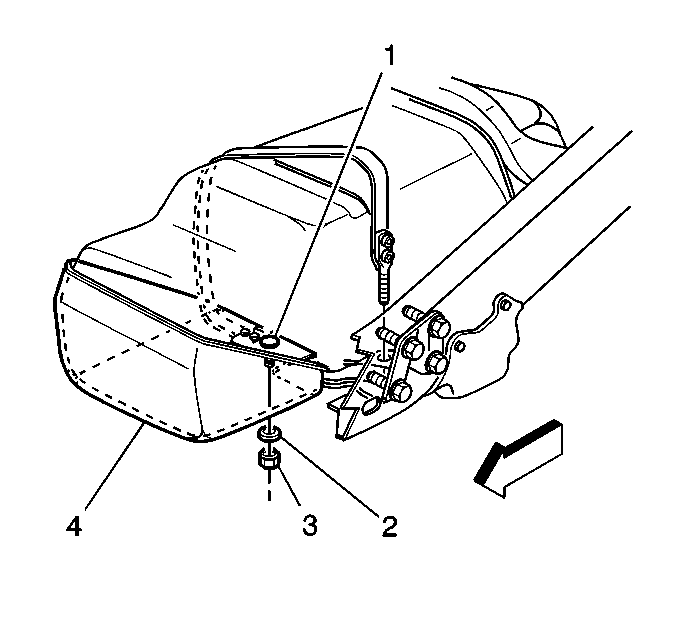

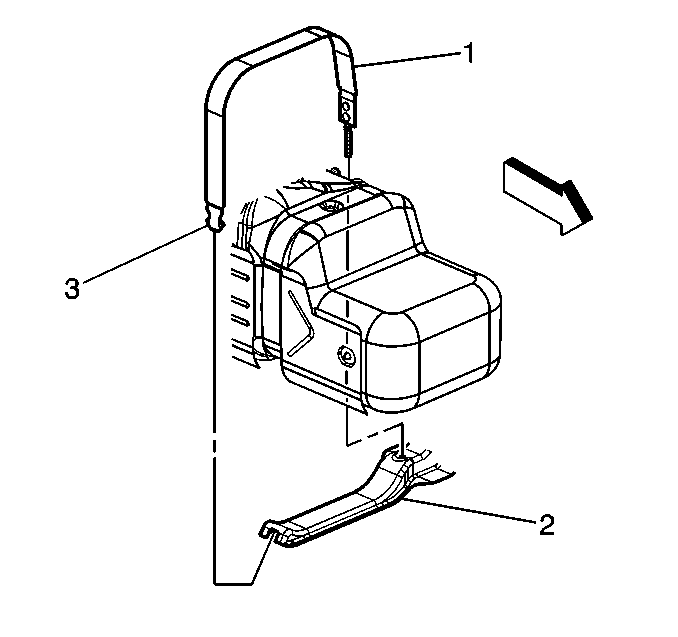
Notice: Ensure that the rollover valve connection and the fuel sender connections are disconnected prior to lowering the fuel tank more than 51 mm (2 in) in order to prevent damage to the fuel tank and the fuel sender.
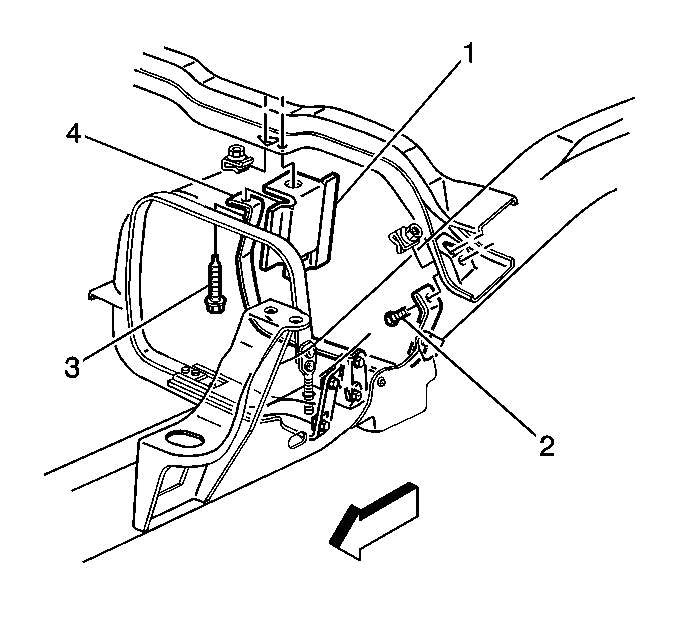
Notice: Use extreme care when lowering the fuel tank. The fuel sender is made of plastic. Lowering the fuel tank may damage the fuel sender.
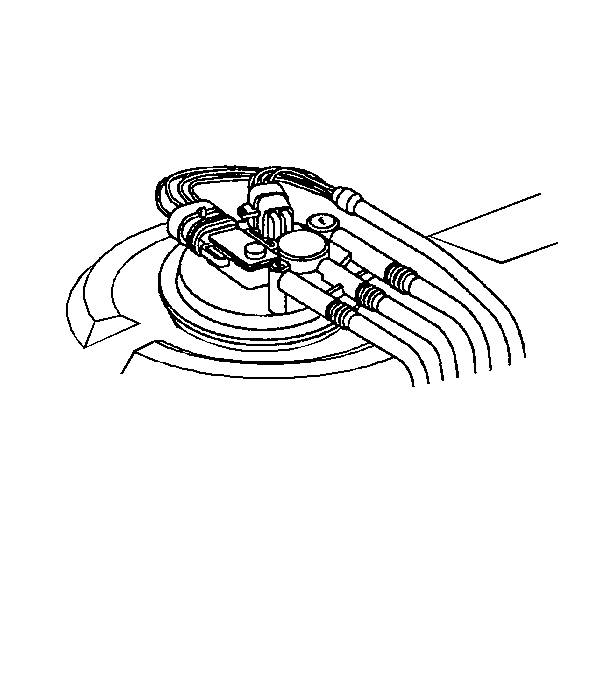
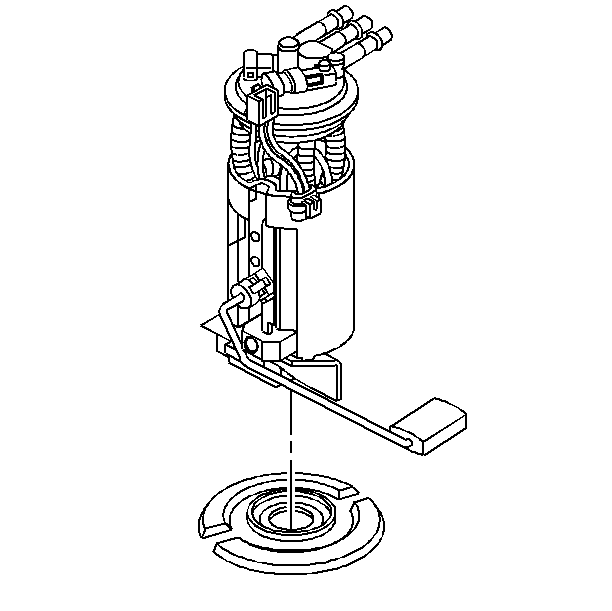
Installation Procedure
- Install the fuel sender into the fuel tank. Refer to Fuel Sender Assembly Replacement .
- Install the fuel tank insulators.
- With the aid of an assistant, position and support the fuel tank.
- Raise the fuel tank.
- Connect the fuel feed pipe, the fuel return pipe, and the EVAP pipe at the fuel sender.
- Connect the fuel pressure sensor and the fuel sender electrical connectors.
- Connect the EVAP pipe to the rollover valve.
- Install the rear fuel tank strap (4) and the protector (2) to the crossmember with the bolt (3) and the retainer (1).
- Install the rear fuel tank strap to frame bolt.
- Install the rear fuel tank shield (without underbody shield package).
- Push the shield (2) onto the horizontal flange of the fuel tank (1).
- The shield (2) is designed with interference to the bottom of the fuel tank (3).
- Install the fuel tank front shield (4), washer (2), and nut (3) (without underbody shield package).
- Install the fuel tank shield to the fuel tank strap bolt (5) with the washer (3) and the nut (4) (4 wheel drive with underbody shield package).
- Install the fuel tank shield to frame bolts (2).
- Tighten the fuel tank shield bolts (2) to 11 N·m (97 lb in).
- Tighten the fuel tank shield nut (4) to 25 N·m (18 lb ft).
- Install the fuel tank shield to crossmember bolts (1) and nuts (6).
- Install the fuel filler pipe. Refer to Filler Tube Replacement .
- Lower the vehicle.
- Refill the fuel tank.
- Install the fuel tank filler cap.
- Connect the negative battery cable.
- Inspect for leaks.




Notice: Use the correct fastener in the correct location. Replacement fasteners must be the correct part number for that application. Fasteners requiring replacement or fasteners requiring the use of thread locking compound or sealant are identified in the service procedure. Do not use paints, lubricants, or corrosion inhibitors on fasteners or fastener joint surfaces unless specified. These coatings affect fastener torque and joint clamping force and may damage the fastener. Use the correct tightening sequence and specifications when installing fasteners in order to avoid damage to parts and systems.
Important: When removing or replacing the fuel tank, the fuel tank support fasteners should never be reused. Always use new fasteners when installing the fuel tank.
Tighten
Tighten the fuel tank strap bolt to 18 N·m (13 lb
ft).

Tighten
Tighten the fuel tank strap bolt to 18 N·m (13 lb
ft).
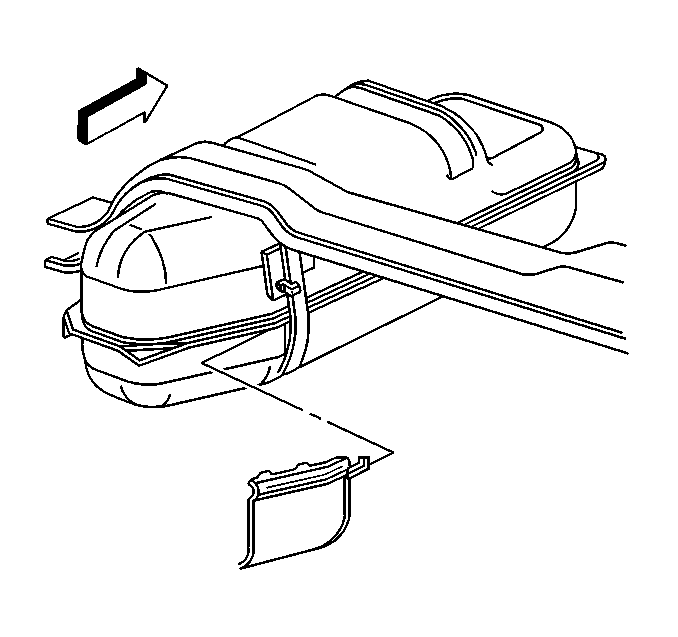


Tighten
Tighten the fuel tank shield nut to 25 N·m (18 lb
ft).

Tighten
Tighten
Tighten the fuel tank shield bolts and nuts to 23 N·m (17 lb
ft).
| 22.1. | Turn ON the ignition for 2 seconds. |
| 22.2. | Turn OFF the ignition for 10 seconds. |
| 22.3. | Turn ON the ignition. |
| 22.4. | Inspect for fuel leaks. |
Fuel Tank Replacement 2-Door Utility
Tools Required
| • | J 34730-1A Fuel Pressure Gauge |
| • | J 39765 Fuel Sender Lock Nut Wrench |
Removal Procedure
- Disconnect the negative battery cable.
- Drain the fuel from the tank. Refer to Fuel Tank Draining .
- Raise the vehicle. Refer to Lifting and Jacking the Vehicle in General Information.
- Remove the left rear splash shield.
- Loosen the fuel fill hose clamp (2) and the vent hose clamp (1) at the fuel tank.
- Disconnect the fuel fill hose and the vent hose from the fuel tank.
- Remove the fuel tank shield.
- Support the fuel tank.
- Remove the fuel tank straps.
- Lower the fuel tank.
- Disconnect the fuel pressure sensor and the fuel sender electrical connectors.
- Disconnect the fuel feed pipe, the fuel return pipe, and the EVAP pipe at the fuel sender.
- Remove the fuel sender from the fuel tank. Refer to Fuel Sender Assembly Replacement .
Caution: Unless directed otherwise, the ignition and start switch must be in the OFF or LOCK position, and all electrical loads must be OFF before servicing any electrical component. Disconnect the negative battery cable to prevent an electrical spark should a tool or equipment come in contact with an exposed electrical terminal. Failure to follow these precautions may result in personal injury and/or damage to the vehicle or its components.
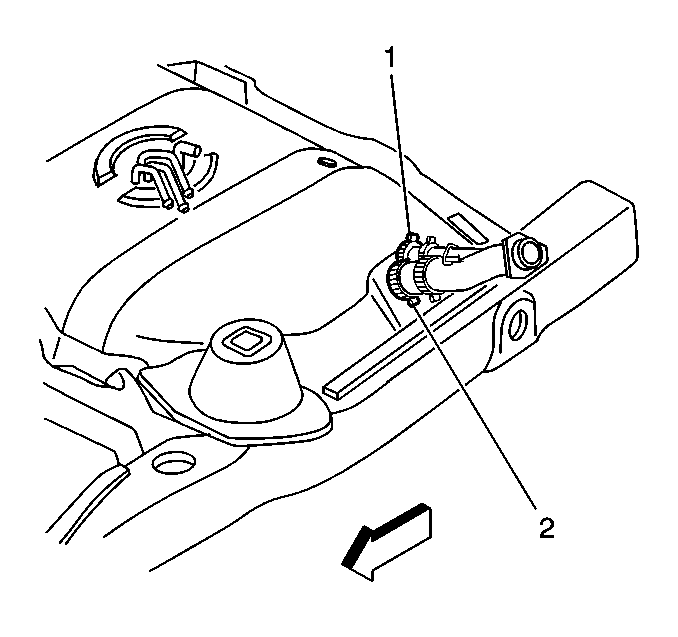
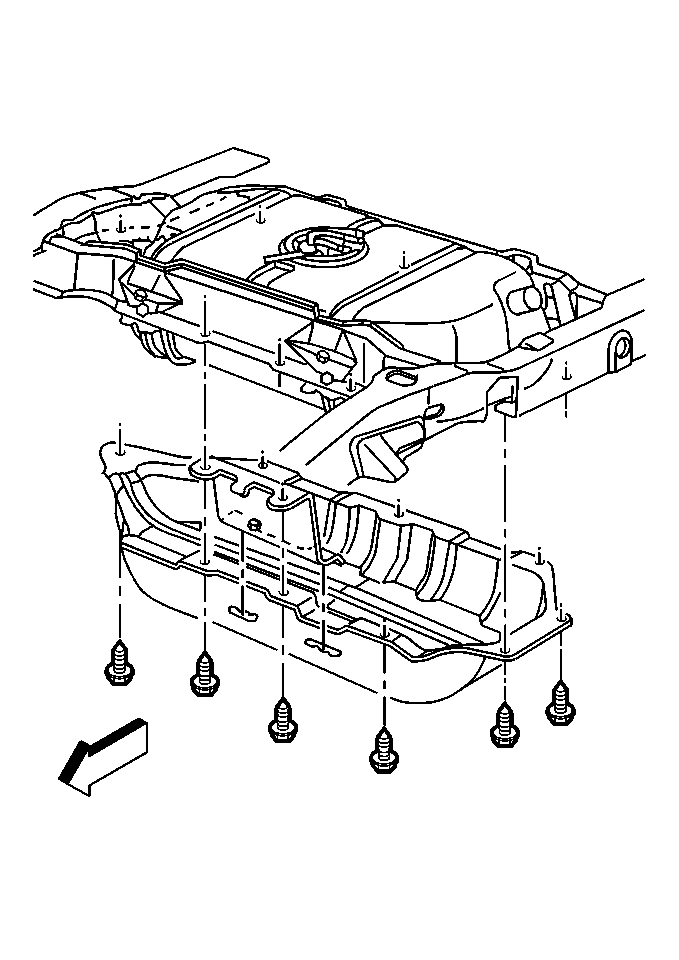

Notice: Use extreme care when lowering the fuel tank. The fuel sender is made of plastic. Lowering the fuel tank may damage the fuel sender.


Installation Procedure
- Install the fuel sender into the fuel tank. Refer to Fuel Sender Assembly Replacement .
- Install the fuel tank insulators.
- With the aid of an assistant, position and support the fuel tank.
- Raise the fuel tank.
- Connect the fuel feed pipe, the fuel return pipe, and the EVAP pipe at the fuel sender.
- Connect the fuel pressure sensor and the fuel sender electrical connectors.
- Install the fuel tank straps.
- Connect the fuel fill hose (2) and the vent hose (1) to the fuel tank.
- Install the left splash shield.
- Install the fuel tank shield.
- Lower the vehicle.
- Refill the fuel tank.
- Install the fuel tank filler cap.
- Connect the negative battery cable.
- Inspect for leaks.

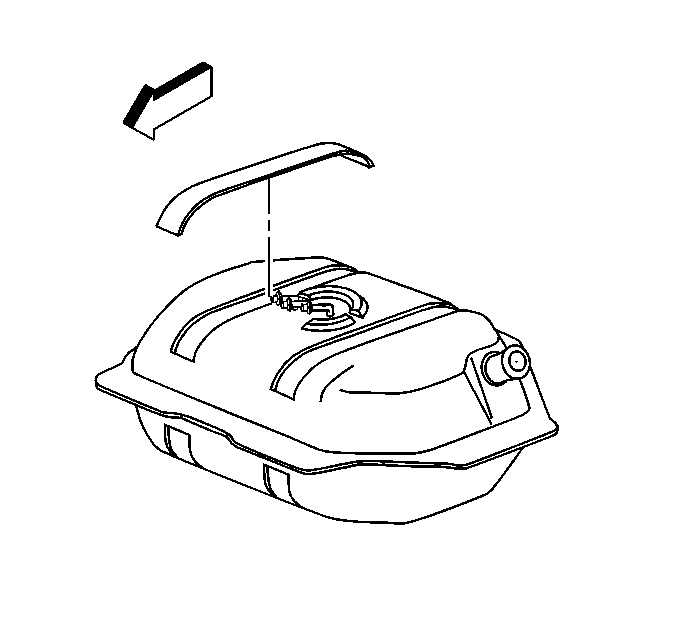


Notice: Use the correct fastener in the correct location. Replacement fasteners must be the correct part number for that application. Fasteners requiring replacement or fasteners requiring the use of thread locking compound or sealant are identified in the service procedure. Do not use paints, lubricants, or corrosion inhibitors on fasteners or fastener joint surfaces unless specified. These coatings affect fastener torque and joint clamping force and may damage the fastener. Use the correct tightening sequence and specifications when installing fasteners in order to avoid damage to parts and systems.
Important: When removing or replacing the fuel tank, the fuel tank support fasteners should never be reused. Always use new fasteners when installing the fuel tank.
Tighten
Tighten the fuel tank strap nuts to 91 N·m (67 lb ft.).

Tighten
| • | Tighten the fuel fill hose clamp to 2.5 N·m (22 lb in). |
| • | Tighten the vent hose clamp to 1.7 N·m (15 lb in). |

Tighten
Tighten the fuel tank shield bolts to 11 N·m (97 lb
in).
| 15.1. | Turn ON the ignition for 2 seconds. |
| 15.2. | Turn OFF the ignition for 10 seconds. |
| 15.3. | Turn ON the ignition. |
| 15.4. | Inspect for fuel leaks. |
Fuel Tank Replacement 4-Door Utility
Tools Required
| • | J 34730-1A Fuel Pressure Gauge |
| • | J 39765 Fuel Sender Lock Nut Wrench |
Removal Procedure
- Disconnect the negative battery cable.
- Drain the fuel from the tank. Refer to Fuel Tank Draining .
- Raise the vehicle. Refer to Lifting and Jacking the Vehicle in General Information.
- Loosen the fuel fill hose clamp (2) and the vent hose clamp (3) at the fuel fill and vent pipe.
- Disconnect the fuel fill hose and the vent hose from the fuel fill and vent pipe.
- Remove the fuel tank shield.
- Disconnect the fuel pressure sensor and the fuel sender electrical connectors.
- Disconnect the fuel feed pipe, the fuel return pipe, and the EVAP pipe at the fuel sender.
- Support the fuel tank.
- Remove the fuel tank straps (1,5).
- Disconnect the EVAP pipes from the rollover valves.
- Lower the fuel tank.
- Remove the fuel sender from the fuel tank. Refer to Fuel Sender Assembly Replacement .
Caution: Unless directed otherwise, the ignition and start switch must be in the OFF or LOCK position, and all electrical loads must be OFF before servicing any electrical component. Disconnect the negative battery cable to prevent an electrical spark should a tool or equipment come in contact with an exposed electrical terminal. Failure to follow these precautions may result in personal injury and/or damage to the vehicle or its components.

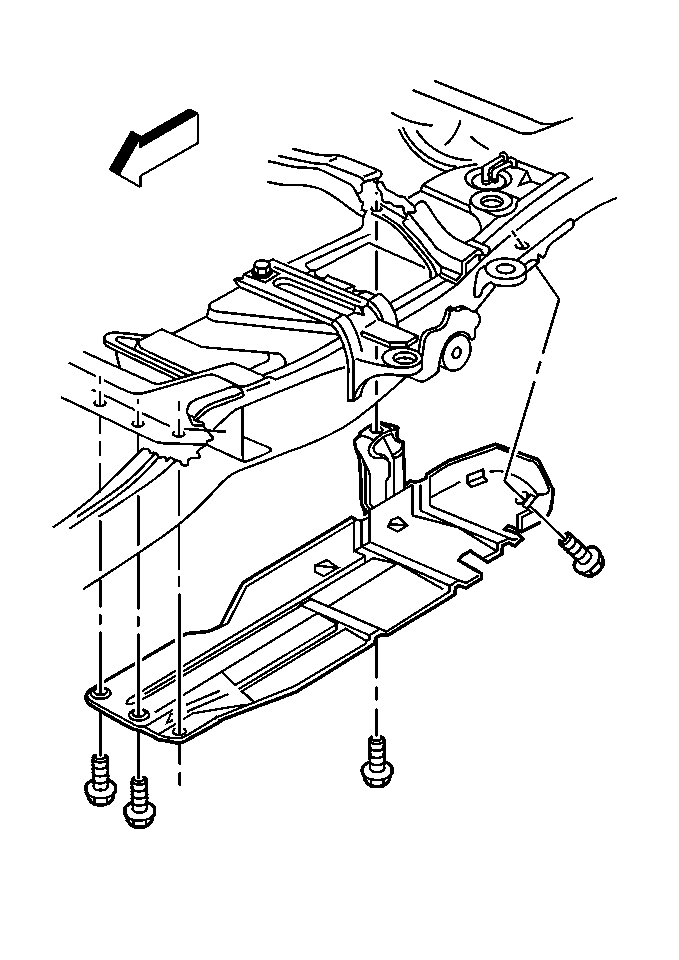


Notice: Ensure that the connections to both roll over valves are disconnected prior to lowering the fuel tank more than 51 mm (2 in). The roll over valves are located at both the front and rear of the fuel tank.
Notice: Use extreme care when lowering the fuel tank. The fuel sender is made of plastic. Lowering the fuel tank may damage the fuel sender.

Installation Procedure
- Install the fuel sender into the fuel tank. Refer to Fuel Sender Assembly Replacement .
- Install the fuel tank insulators.
- With the aid of an assistant, position and support the fuel tank.
- Raise the fuel tank.
- Connect the EVAP pipes to the rollover valves.
- Install the fuel tank straps.
- Connect the fuel feed pipe, the fuel return pipe, and the EVAP pipe at the fuel sender.
- Connect the fuel pressure sensor and the fuel sender electrical connectors.
- Connect the fuel fill hose and the vent hose to the fuel fill and vent pipe.
- Install the fuel tank shield.
- Lower the vehicle.
- Refill the fuel tank.
- Install the fuel tank filler cap.
- Connect the negative battery cable.
- Inspect for leaks.


Notice: Use the correct fastener in the correct location. Replacement fasteners must be the correct part number for that application. Fasteners requiring replacement or fasteners requiring the use of thread locking compound or sealant are identified in the service procedure. Do not use paints, lubricants, or corrosion inhibitors on fasteners or fastener joint surfaces unless specified. These coatings affect fastener torque and joint clamping force and may damage the fastener. Use the correct tightening sequence and specifications when installing fasteners in order to avoid damage to parts and systems.
Important: When removing or replacing the fuel tank, the fuel tank support fasteners should never be reused. Always use new fasteners when installing the fuel tank.
Tighten
| • | Tighten the fuel tank strap nut (3) to 18 N·m (13 lb ft.). |
| • | Tighten the fuel tank strap bolt (2) to 18 N·m (13 lb ft.). |


Tighten
| • | Tighten the fuel fill hose clamp (2) to 2.5 N·m (22 lb in). |
| • | Tighten the vent hose clamp (3) to 1.7 N·m (15 lb in). |

Tighten
Tighten the fuel tank shield bolts (2) to 33 N·m (24 lb
ft).
| 15.1. | Turn ON the ignition for 2 seconds. |
| 15.2. | Turn OFF the ignition for 10 seconds. |
| 15.3. | Turn ON the ignition. |
| 15.4. | Inspect for fuel leaks. |
